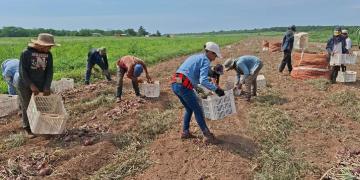Europa: Refining the understanding of the mechanisms of potato tuberisation
As part of ADAPT’s work to develop multiple-stress tolerant potatoes, the project’s consortium has been conducting a research to understand the signaling mechanisms of potato tuber formation and how they are impacted by environmental stresses.

Work from several of the partner laboratories has refined the understanding of the action of the ‘master regulator’ of tuberisation and identified a candidate gene for a key step in the tuberisation process. These genes are targets for breeding improved potato cultivars able to maintain yields under adverse environmental conditions.
Tuber induction is initiated in the leaves, where daylength controls the production of the tuberisation signal SP6A. This mobile protein enters the phloem, which also supports the transport of sugars from leaves to below ground organs, and travels to the underground stems or stolons. Here, it activates tuber identity genes which initiates tuber formation.
It is well established that stresses such as high temperature inhibit production of the SP6A signal and this inhibition is responsible for the yield loss observed under heat stress. However, SP6A appears to be less affected by other stresses and hence the mechanism of yield reduction under these conditions remains to be fully elucidated.
SP6A is a member of a family of proteins with roles in a diverse range of developmental processes such as flowering, branching and root development. Other family members include TFL1B and TFL1C which in related species such as tomato control the number and location of flowers.
It is now known that for SP6A to induce tuber formation, it needs to cooperative with other proteins from the bZIP transcription factor family, held together in a complex scaffolded by 14-3-3 proteins. This complex binds specific stretches of DNA to activate tuber identity genes.
To understand whether TFL1B and TFL1C also regulate tuber formation, ADAPT researchers generated plants in which expression of these genes was reduced. These plants formed earlier tubers and had higher tuber yields both under optimal and stressful conditions.
In a series of molecular and biochemical experiments, the team discovered that TFL1B and TFL1C could replace SP6A in protein complexes with bZIP transcription factors and 14-3-3 proteins. However, when SP6A was replaced different genes were activated and tuberisation was not induced. This indicates that TFL1B and TFL1C compete with SP6A in plant tissues to reduce tuberisation. When TFL1B or TFL1C gene expression is reduced less SP6A is required for tubers to form.
In the reduced TFL1B and TFL1C lines the expression of genes encoding GERMINS was highly upregulated. In a different set of plants where the GERMIN3 gene was upregulated, tuberisation occurred sooner and yields were higher. It was found that GERMIN3 regulates the transfer of sugars to the developing tuber, an essential process identified more than 20 years ago.
These results have significantly advanced ADAPT’s consortium understanding of the mechanisms signaling potato tuberisation and how tuber formation can be blocked by adverse environmental conditions. TFL1B, TFL1C and GERMINS were identified as main targets for the generation of new cultivars that exhibit yield maintenance under adverse conditions. Such targets can be exploited either using marker assisted breeding or new precision breeding technologies.
Fuente: https://backend.univie.ac.at/fileadmin/_processed_/csm_20240319_094248-980x552_a876c14b7e.jpg




